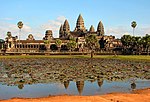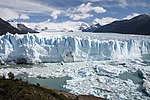Convention and background[edit]
The United States initiated the idea of cultural conservation with nature conservation. A White House conference in 1965 called for a 'World Heritage Trust' to preserve "the world's superb natural and scenic areas and historic sites for the present and the future of the entire world citizenry." The International Union for Conservation of Nature developed similar proposals in 1968, and they were presented in 1972 to the United Nations conference on Human Environment in Stockholm. Under the World Heritage Committee signatory countries are required to produce and submit periodic data reporting providing the World Heritage Committee with an overview of each participating nation's implementation of the World Heritage Convention and a "snapshot" of current conditions at World Heritage properties.
A single text was agreed on by all parties, and the Convention concerning the Protection of the World Cultural and Natural Heritage was adopted by the General Conference of UNESCO on 16 November 1972.
The Convention came into force on 17 December 1975. As of June 2014, it has been ratified by 191 states, which includes 187 UN member states plus the Cook Islands, the Holy See, Niue, and the Palestinian territories.[6]
Nominating process[edit]
A country must first take an inventory of its significant cultural and natural properties. This is called the Tentative List. A country may not nominate properties that have not been included on the Tentative List. Next, it can select a property from this list to place into a Nomination File.
At this point, the file is evaluated by the International Council on Monuments and Sites and the World Conservation Union. These bodies then make their recommendations to the World Heritage Committee. The Committee meets once per year to determine whether or not to inscribe each nominated property on the World Heritage List, and sometimes defers the decision to request more information from the country who nominated the site. There are ten selection criteria – a site must meet at least one of them to be included on the list.
Selection criteria[edit]
Until the end of 2004, there were six criteria for cultural heritage and four criteria for natural heritage. In 2005, this was modified so that there is only one set of ten criteria. Nominated sites must be of "outstanding universal value" and meet at least one of the ten criteria.[7]



















No comments:
Post a Comment